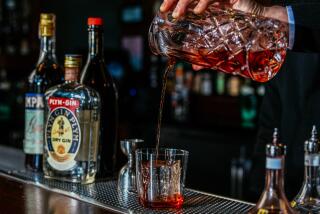How to Deal With a Wine That’s Still Before Its Time
- Share via
The biggest problem with restaurant wine lists today (high prices aside) is wine that’s too young. Red wines--and even many white wines--are simply too immature to drink when they’re just released.
Young wine goes into a depression soon after bottling. Time is the best cure; it needs to be left alone for a while--a year for most Chardonnays and two for deep red wines.
Even when it’s happy again, shipping wine hundreds of miles forces it to go into a kind of bottle shock. Winemakers say some wine doesn’t “travel well,” the vinous equivalent of getting jet lag.
Then, too, young wine needs time for the flavors to marry. Few restaurants have the storage space to properly age wine until it begins tasting like wine instead of grape juice with alcohol.
And so when you walk into a restaurant, even a very good one, you’re unlikely to find California Chardonnays from the good 1989 vintage. Instead you’re offered 1990s. Some 1991s are already out.
With red wines, the situation is worse: You see few California Cabernet Sauvignons from the fine 1987 vintage. What you see are wines from 1988, an awkward year for wine; right now, these wines will be coarse and rough with tannins. They need at least another year of bottle age to become drinkable.
There are two solutions to the problem of young wine in restaurants. You can bring your own older wine with you. Or you can decant the wine you order.
In the case of a 1991 Chardonnay or a 1989 Cabernet or any other very young wine, I would almost always suggest decanting the wine. And I don’t mean any of this upraised-pinky gentility where some snoot, by candlelight, slowly dribbles the wine into a decanter. Instead, splash the wine roughly. The wine needs air, and splashing it infuses oxygen and allows the wine to “breathe” and open up. Even most young Chardonnays will benefit from this practice.
Tannin in red wine and odd aromas in young white wine may be reduced by this splashing. Aeration mimics what the winery does while making the wine.
How do you decide whether to ask that the wine be decanted? Taste it. When the waiter pours out the sip after you’ve ordered, consider the taste. Is it fresh and fragrant? Or does it seem mute, coarse or slightly pungent? If you’re not sure, pass the glass to others at the table and solicit their opinions.
Some points of caution:
* If you plan be to sitting at dinner for more than an hour with a decanter of wine, it might be wise to get a decanter with a stopper. Too much air can harm the aroma of any wine. In a pinch, a piece of plastic wrap over the top of the decanter will protect the wine from excessive air.
* Decanting is unnecessary with most very light wines, such as Chenin Blanc, Gewurztraminer and Riesling. And clearly it is inappropriate for sparkling wine.
* Avoid decanters made of stoneware or metal. A clean glass decanter is best, a water pitcher a good alternative.
* Be careful when decanting any wine known to be unfined or unfiltered. (Some wineries now state the process on the label.) Some sediment may get into the decanter if you’re not careful. There is no harm in this, but it is unsightly.
Is it too much to ask that a restaurant have decanters on hand? I think not. To be sure, decanting wine is not a common practice in American dining. It is done regularly only in formal restaurants that have sommeliers. But even in more modest surroundings, you are paying a lot for the privilege of ordering wine. You are usually asked to pay $35 for a bottle of wine that sells at retail for $17; that bottle costs the restaurant less than $12.
For the $23 the restaurant makes on that bottle, it should be prepared to do more than simply open it up and pour it out.
More to Read
Eat your way across L.A.
Get our weekly Tasting Notes newsletter for reviews, news and more.
You may occasionally receive promotional content from the Los Angeles Times.







